Closing the Gap of Building Energy Performance
Added on 2022-12-23
40 Pages9530 Words1 Views
RESEARCH PROJECT
By Name
Course
Instructor
Institution
Location
Date
By Name
Course
Instructor
Institution
Location
Date
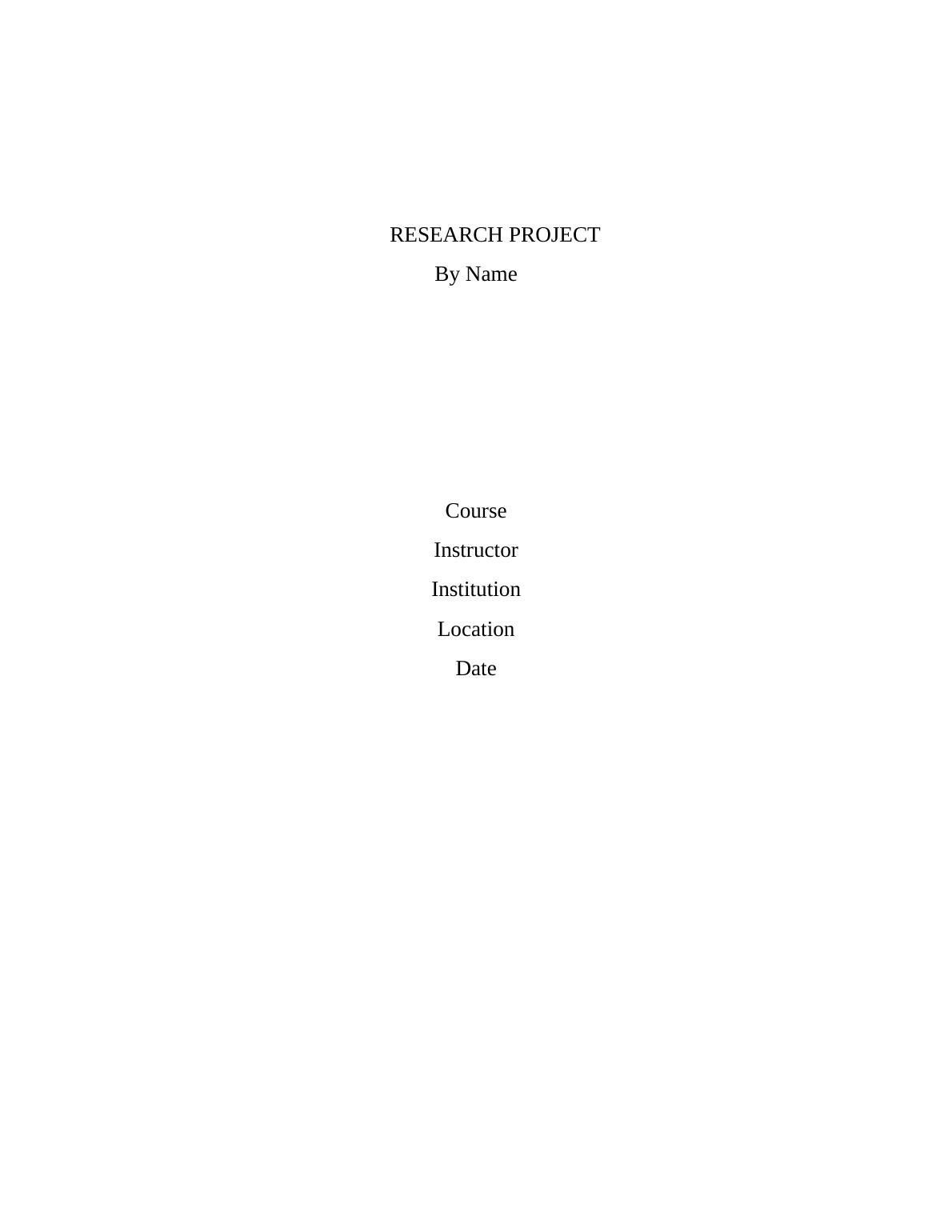
Contents
Introduction................................................................................................................ 2
Energy Performance Gap, Enablers & Barriers........................................................3
Importance of closing the gap of building energy performance...........................3
Reasons for the difficulty in the prediction of building energy consumption...........7
Hypotheses and goals........................................................................................... 10
Enablers................................................................................................................ 11
Barriers.................................................................................................................. 12
BIM Functionalities wrt BMS & Energy Performance Gap, Enablers & barriers.........13
BIM – Energy Analysis Tool – BMS Link...............................................................14
BIM-Energy Consumption Viewer Plugin Link.....................................................14
Implementation of the prototype on the selected building in Australia.................19
Measures of the Energy Performance (Thematic Analysis)................................22
Barriers.............................................................................................................. 28
Integration of BIM, BMS to minimize Energy Performance Gap using matrix...........30
Fundamental concepts....................................................................................... 30
Models................................................................................................................ 30
Verification and validation of the model using matrix........................................30
Prediction verification........................................................................................ 34
Verification and validation in the building performance domain........................35
CONCLUSIONS.......................................................................................................... 38
REFERENCES............................................................................................................ 38
Introduction
Increasing research work has indicated that the predicted energy performance of the
structures deviates significantly from the actual measured energy use. This is what referred to as
the performance gap is common. This particular gap is capable of undermining the confidence of
Introduction................................................................................................................ 2
Energy Performance Gap, Enablers & Barriers........................................................3
Importance of closing the gap of building energy performance...........................3
Reasons for the difficulty in the prediction of building energy consumption...........7
Hypotheses and goals........................................................................................... 10
Enablers................................................................................................................ 11
Barriers.................................................................................................................. 12
BIM Functionalities wrt BMS & Energy Performance Gap, Enablers & barriers.........13
BIM – Energy Analysis Tool – BMS Link...............................................................14
BIM-Energy Consumption Viewer Plugin Link.....................................................14
Implementation of the prototype on the selected building in Australia.................19
Measures of the Energy Performance (Thematic Analysis)................................22
Barriers.............................................................................................................. 28
Integration of BIM, BMS to minimize Energy Performance Gap using matrix...........30
Fundamental concepts....................................................................................... 30
Models................................................................................................................ 30
Verification and validation of the model using matrix........................................30
Prediction verification........................................................................................ 34
Verification and validation in the building performance domain........................35
CONCLUSIONS.......................................................................................................... 38
REFERENCES............................................................................................................ 38
Introduction
Increasing research work has indicated that the predicted energy performance of the
structures deviates significantly from the actual measured energy use. This is what referred to as
the performance gap is common. This particular gap is capable of undermining the confidence of

an individual in relation to the energy efficiency in a building. It is such initiatives that have
necessitated the role of the building energy efficiency in most of the buildings. It has been a
challenge though to have this particular gap closed by the involved professionals especially when
it comes to their stimulation so as to reflect on the ways of the investigation as well as a better
understanding of the origin, size as well as the size of the gap.
Energy Performance Gap, Enablers & Barriers
Importance of closing the gap of building energy performance
Improvement in the performance of energy is the major concern in sustainable building
design influenced by environmental issues and global energy demands. Improvement in the
performance of energy of the built environment through retrofit of existing buildings and the new
design has generally resulted in an increase in energy saving. There are models designed to
compute the amount of energy building consumed based on the performance of retrofit and
design. The models are also used to facilitate testing procedures against codes of building energy
and potential saving assessment by retrofit of existing buildings(Kampelis et al.2017). With the
current technologies, an efficient improvement with the greater percentage in the building energy
has been realized by building energy models. The researchers through their extensive study work
have disclosed that in future new technologies may emerge with new buildings in the sector of a
commercial saving a greater percentage of energy being zero as part net of a commercial
building.
These kinds of predictions have been made based on the assumption that there are adequate tools
available for the new designs and plan retrofits only are when the goals can be achieved. Studies
have been done recently which show that the assumptions made concerning the predictions are
necessitated the role of the building energy efficiency in most of the buildings. It has been a
challenge though to have this particular gap closed by the involved professionals especially when
it comes to their stimulation so as to reflect on the ways of the investigation as well as a better
understanding of the origin, size as well as the size of the gap.
Energy Performance Gap, Enablers & Barriers
Importance of closing the gap of building energy performance
Improvement in the performance of energy is the major concern in sustainable building
design influenced by environmental issues and global energy demands. Improvement in the
performance of energy of the built environment through retrofit of existing buildings and the new
design has generally resulted in an increase in energy saving. There are models designed to
compute the amount of energy building consumed based on the performance of retrofit and
design. The models are also used to facilitate testing procedures against codes of building energy
and potential saving assessment by retrofit of existing buildings(Kampelis et al.2017). With the
current technologies, an efficient improvement with the greater percentage in the building energy
has been realized by building energy models. The researchers through their extensive study work
have disclosed that in future new technologies may emerge with new buildings in the sector of a
commercial saving a greater percentage of energy being zero as part net of a commercial
building.
These kinds of predictions have been made based on the assumption that there are adequate tools
available for the new designs and plan retrofits only are when the goals can be achieved. Studies
have been done recently which show that the assumptions made concerning the predictions are
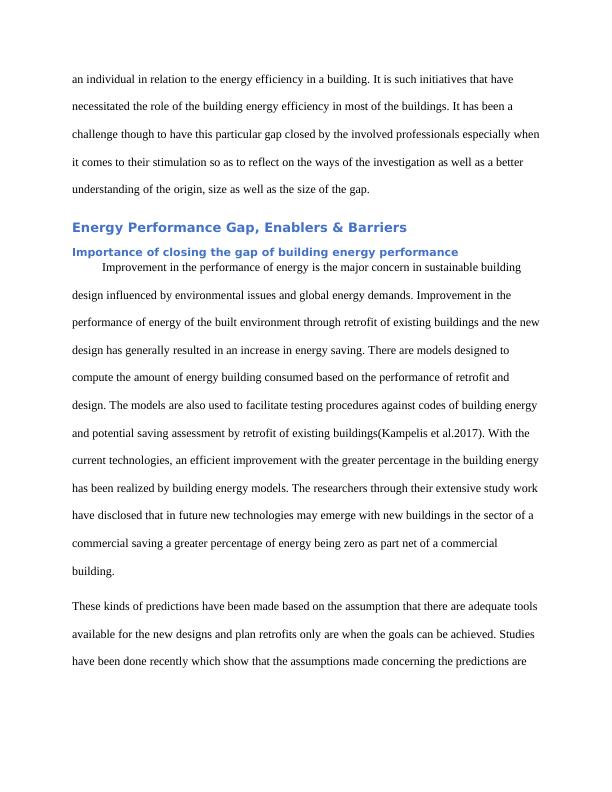
optimistic and opportunistic for example the study which was conducted on the performance of
energy in the measurement and prediction of new construction commercial buildings.
In the figure below, the first diagram indicates the results of ratio of measured to predicted
EUI against the predicted Energy Use Intensity (EUI) in kBtu/SF at design state by use of
building energy dynamic simulation. The second diagram illustrates the range in the ratio of
three tiers of LEED certification.
Figure 1: showing predicted and measured EUI of LEED buildings(Khoury, Hollmuller and
Lachal 2016).
From the diagram above, it can be clearly seen that an increase in certification tiers
increases the variations of the ratios. Therefore, it can be declared that projects that require large
amounts of energy performance are likely to underperform in actual energy use. The unregulated
loads were important parameters which were used in the result predictions in the above figure.
However, the values which were obtained are not the actual exact values assumed. In each
model, plug loads were specifically adjusted to about 25% in total consumed energy with regard
to the baseline model which usually appears to be higher than the original values which were
energy in the measurement and prediction of new construction commercial buildings.
In the figure below, the first diagram indicates the results of ratio of measured to predicted
EUI against the predicted Energy Use Intensity (EUI) in kBtu/SF at design state by use of
building energy dynamic simulation. The second diagram illustrates the range in the ratio of
three tiers of LEED certification.
Figure 1: showing predicted and measured EUI of LEED buildings(Khoury, Hollmuller and
Lachal 2016).
From the diagram above, it can be clearly seen that an increase in certification tiers
increases the variations of the ratios. Therefore, it can be declared that projects that require large
amounts of energy performance are likely to underperform in actual energy use. The unregulated
loads were important parameters which were used in the result predictions in the above figure.
However, the values which were obtained are not the actual exact values assumed. In each
model, plug loads were specifically adjusted to about 25% in total consumed energy with regard
to the baseline model which usually appears to be higher than the original values which were
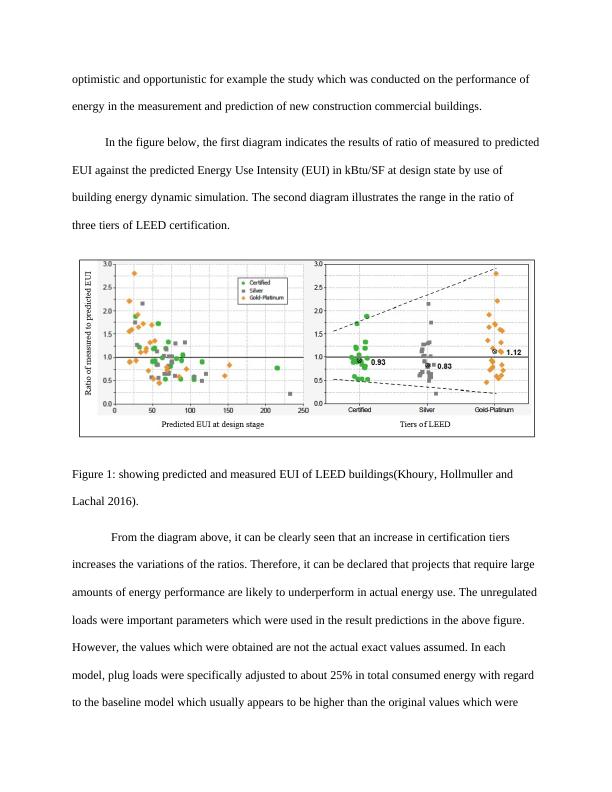
assumed. The reasons for the reasons were stated by the researchers in their report. In case the
plug loads are designed in the same way as in the original models, there would be an increased
ratio of variation of the predicted EUI and the mean also would be much low than what is
indicated in the above figure(Khoury, Hollmuller and Lachal 2016). The prediction of the
building energy consumption based on modeling procedures as used in the system of LEED was
also reported and it showed that the level of accuracy of prediction of the modeling procedures
was low. It is however still remaining in doubt if the efficient alternative energy strategies in the
support of decision design could adequately be evaluated by the results of the simulation.
The residential domains had a worse situation than what the commercial domain depicts. There
was a study which was carried out by the National Renewable Energy Laboratory (NREL) to
evaluate the accuracy of various modeling systems on the prediction of energy performance in
residential houses. The comparison of utility billing data and predicted electric energy
consumption is shown in the diagram below.
Figure 2: showing predicted and measured home usage of electricity(Kampelis et al 2017)
plug loads are designed in the same way as in the original models, there would be an increased
ratio of variation of the predicted EUI and the mean also would be much low than what is
indicated in the above figure(Khoury, Hollmuller and Lachal 2016). The prediction of the
building energy consumption based on modeling procedures as used in the system of LEED was
also reported and it showed that the level of accuracy of prediction of the modeling procedures
was low. It is however still remaining in doubt if the efficient alternative energy strategies in the
support of decision design could adequately be evaluated by the results of the simulation.
The residential domains had a worse situation than what the commercial domain depicts. There
was a study which was carried out by the National Renewable Energy Laboratory (NREL) to
evaluate the accuracy of various modeling systems on the prediction of energy performance in
residential houses. The comparison of utility billing data and predicted electric energy
consumption is shown in the diagram below.
Figure 2: showing predicted and measured home usage of electricity(Kampelis et al 2017)
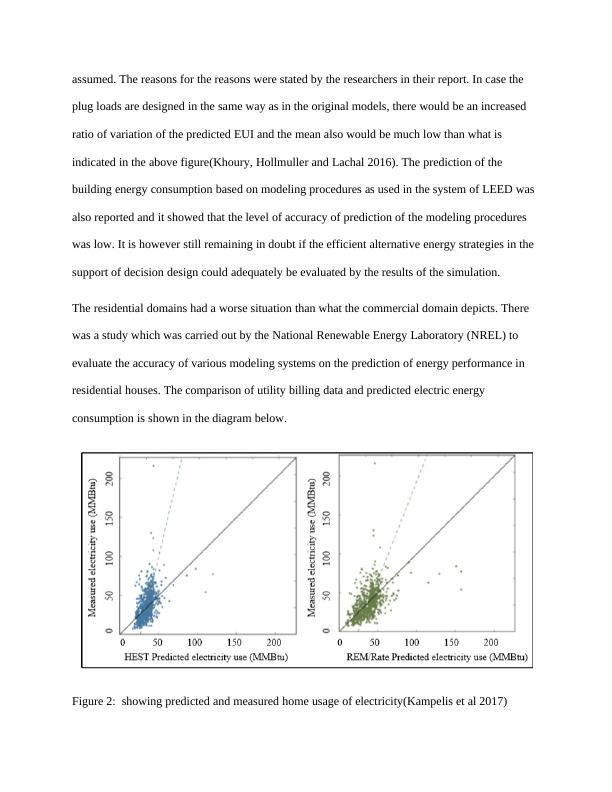
The first diagram shows predictions from the primary development of the Home Energy
Scoring Tool (HEST) at Lawrence Berkeley National Laboratory. Used in the Energy
Department to provide useful information to the program of building technology, this kind of
technology has proved to be very viable in some aspects. The second diagram is an illustration of
the predictions from REM or the energy rating software developed by Architectural Energy
Corporation commonly used in Home Energy Rating Systems (HERS). Predictions for HEST
and REM/Rate were seen to have a deviation from the measured electricity use. The predictions
on electricity use according to HEST showed that electricity use in homes is lower compared to
the variation on measured electricity use while measurements in REM/Rate was seen to be
consistent. There is a lot of research which is still on the process to improve on the prediction
accuracy.
The diagrams, when looked at jointly show that the energy consumed by the existing
houses was totally different from what was predicted by the energy building models. Energy
performance gap on its magnitude adversely affects various building groups such as owners,
model developers, occupants, modelers, and involved policy makers either in the provision or
usage of the predictions. In an attempt to raise the major concern on the issue, the researchers
referred to the performance gap as a credibility gap. In some countries, it has been made a
legislative requirement that with regard to the actual amount of energy consumed a public
notification by Display and Energy Certificate is recommended. Team of designers including the
DEC showed that the consistency between different predicted building energy performances was
low. For that reason, with the increased interest in the issue of the performance gap, there is
growth in the research sector and industrial communities(Khoury, Hollmuller and Lachal 2016).
Scoring Tool (HEST) at Lawrence Berkeley National Laboratory. Used in the Energy
Department to provide useful information to the program of building technology, this kind of
technology has proved to be very viable in some aspects. The second diagram is an illustration of
the predictions from REM or the energy rating software developed by Architectural Energy
Corporation commonly used in Home Energy Rating Systems (HERS). Predictions for HEST
and REM/Rate were seen to have a deviation from the measured electricity use. The predictions
on electricity use according to HEST showed that electricity use in homes is lower compared to
the variation on measured electricity use while measurements in REM/Rate was seen to be
consistent. There is a lot of research which is still on the process to improve on the prediction
accuracy.
The diagrams, when looked at jointly show that the energy consumed by the existing
houses was totally different from what was predicted by the energy building models. Energy
performance gap on its magnitude adversely affects various building groups such as owners,
model developers, occupants, modelers, and involved policy makers either in the provision or
usage of the predictions. In an attempt to raise the major concern on the issue, the researchers
referred to the performance gap as a credibility gap. In some countries, it has been made a
legislative requirement that with regard to the actual amount of energy consumed a public
notification by Display and Energy Certificate is recommended. Team of designers including the
DEC showed that the consistency between different predicted building energy performances was
low. For that reason, with the increased interest in the issue of the performance gap, there is
growth in the research sector and industrial communities(Khoury, Hollmuller and Lachal 2016).
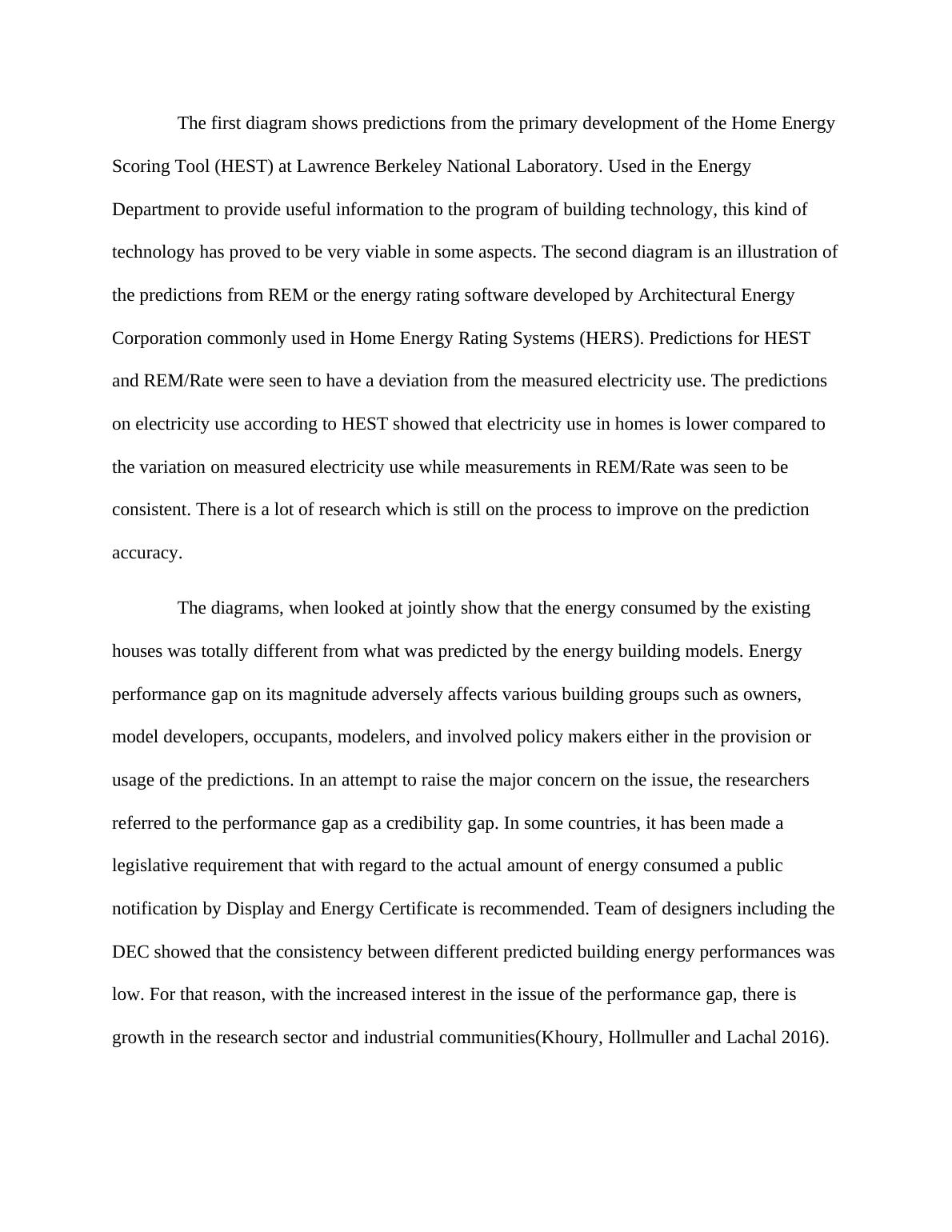
Despite the reasons for observed building energy performance gap, consisting of
administrative and technical issues, a lot of questions arise about the quality performance of the
model predictions provided that measurements give the direct way to observe the reality rather
than running a computer model. The current technology has made it easy to measure the amounts
of electric energy used and errors that may occur in the measurements like in the predictions are
possibly avoided. Therefore, there is an agreement reached by the research and practice domain
on the poor model prediction on energy consumption for commercial or residential buildings at
the stage of design. The general utility of modeling results in technology and design support
decisions for multiple or individual buildings at an aggregate level.
Reasons for the difficulty in the prediction of building energy
consumption.Content and Qualitative analysis
People need to understand the reality they interact with for their advantage which can be
achieved by the built models. The building energy predictions shown in the above figures cannot
be fully relied on because the tools which were used were not to the required standards of
application. The developers of the tools which were used for the research to some extent did not
think enough before the application of the tool to the real world. The limitations in prediction
results can, therefore, be related to lack of data or knowledge based on the following: (1) quality
assurance of the tool like coding errors; (2) required experience of modeling and suitable
submodels or models used for building conceptualization specifications; (3) existing models and
sub-models in the complicated real world environment having no relations with the conditions of
the laboratory testing; (4) proper information on critical input parameters such as plug loads and
lighting.
administrative and technical issues, a lot of questions arise about the quality performance of the
model predictions provided that measurements give the direct way to observe the reality rather
than running a computer model. The current technology has made it easy to measure the amounts
of electric energy used and errors that may occur in the measurements like in the predictions are
possibly avoided. Therefore, there is an agreement reached by the research and practice domain
on the poor model prediction on energy consumption for commercial or residential buildings at
the stage of design. The general utility of modeling results in technology and design support
decisions for multiple or individual buildings at an aggregate level.
Reasons for the difficulty in the prediction of building energy
consumption.Content and Qualitative analysis
People need to understand the reality they interact with for their advantage which can be
achieved by the built models. The building energy predictions shown in the above figures cannot
be fully relied on because the tools which were used were not to the required standards of
application. The developers of the tools which were used for the research to some extent did not
think enough before the application of the tool to the real world. The limitations in prediction
results can, therefore, be related to lack of data or knowledge based on the following: (1) quality
assurance of the tool like coding errors; (2) required experience of modeling and suitable
submodels or models used for building conceptualization specifications; (3) existing models and
sub-models in the complicated real world environment having no relations with the conditions of
the laboratory testing; (4) proper information on critical input parameters such as plug loads and
lighting.

For a better understanding of the limitations and sources of errors associated with the
building energy consumption, the description of the models involved and their purposes based on
construction, operation, and design should be clear. The computer building energy model
predicts the Energy Use Intensity (EUI) and formulates the annual average of (EUI) for a long
duration of time usually years. The figure below shows the computer model used in the design
state "as-built" to predict building performance "as-operated".
Figure 4: Figure of computer modeling building operational performance at the design
stage(Kampelis et al 2017).
The uncertainties arise at the time of prediction where various parameters of the input
model are unknown. For example, there are variations in the quality of construction in the design
implementation specifications by the construction team. The variations can induce some defects
and particular effects on the design. The errors like the broken temperature sensor and sloppily
installed air ducts are not system prevalent aspects included in the model and their effects and
occurrences are not easy to predict. It is also important to note that the determination of the
building energy consumption, the description of the models involved and their purposes based on
construction, operation, and design should be clear. The computer building energy model
predicts the Energy Use Intensity (EUI) and formulates the annual average of (EUI) for a long
duration of time usually years. The figure below shows the computer model used in the design
state "as-built" to predict building performance "as-operated".
Figure 4: Figure of computer modeling building operational performance at the design
stage(Kampelis et al 2017).
The uncertainties arise at the time of prediction where various parameters of the input
model are unknown. For example, there are variations in the quality of construction in the design
implementation specifications by the construction team. The variations can induce some defects
and particular effects on the design. The errors like the broken temperature sensor and sloppily
installed air ducts are not system prevalent aspects included in the model and their effects and
occurrences are not easy to predict. It is also important to note that the determination of the

End of preview
Want to access all the pages? Upload your documents or become a member.
Related Documents
Advanced Construction Project Managementlg...
|29
|6337
|64
